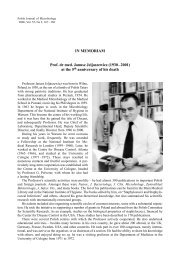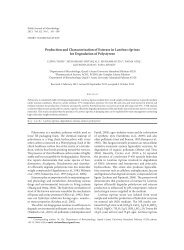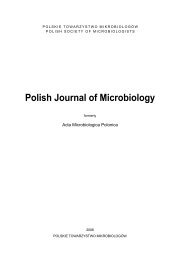No 3 - Polish Journal of Microbiology
No 3 - Polish Journal of Microbiology
No 3 - Polish Journal of Microbiology
Create successful ePaper yourself
Turn your PDF publications into a flip-book with our unique Google optimized e-Paper software.
210<br />
distilled water, the seeds were transferred onto Petri<br />
dishes containing potato dextrose agar (PdA, dIFCO,<br />
detroit, MI. USA) with 13 mg/l kanamycin sulphate<br />
added after autoclaving and incubated for 10 days,<br />
at 23 ± 1°C in the dark to allow mycelial growth and<br />
sporulation. All isolates were identified morphologically<br />
according to Nelson et al. (1983). In previous studies,<br />
different wheat genotypes had been inoculated with<br />
105 fungal isolates, evaluating host-pathogen reactions<br />
using the method described by Kiprop et al. (2002).<br />
Emphasis was placed on selecting isolates that induced<br />
differential reactions on specific genotypes (Alazem,<br />
2007), leading to selection <strong>of</strong> the 21 monosporic isolates<br />
(eight belonging to F. culmorum, four to F. solani,<br />
six to F. verticillioides and three to F. equiseti) used in<br />
this study. The Fusarium isolates, their host plants, and<br />
geographic origin are listed in Table I. The cultures were<br />
maintained on silica gel at 4°C until needed.<br />
Xylanase production medium. Enzyme production<br />
by the selected isolates was carried out in 250 ml Erlenmeyer<br />
flasks containing 5 g <strong>of</strong> solid substrate and nutrients<br />
(based on 100 ml <strong>of</strong> liquid medium) plus distilled<br />
water to adjust the moisture content to 75%. The fermentation<br />
medium consisted <strong>of</strong>: (g/L) Na 2 HPO 4 × 2H 2 O 10;<br />
KCl 0.5; MgSO 4 × 7H 2 O 0.15, and Yeast extract 5, as<br />
a nitrogen source. The influences <strong>of</strong> different lignocellulosic<br />
materials (wheat bran, beet pulp and cotton seed<br />
cake) on xylanase production were tested. Fresh fungal<br />
spores have been used as inoculums and 1 mL spore<br />
suspension (containing around 10 6 spores/mL) was<br />
added to sterilized medium and incubated at 30°C. The<br />
flasks were removed after cultivation and the enzyme<br />
was extracted by adding distilled water containing 0.1%<br />
Triton × 100 to make the volume in a flask 100 mL. The<br />
flasks’ contents were stirred for 1.5 hours on a magnetic<br />
stirrer. The clear supernatant was obtained by centrifugation<br />
(5000 × g for 15 min) followed by filtration<br />
(Whatman no 1 paper).<br />
Enzyme assay. xylanase activity was assayed by the<br />
optimized method described by Bailey et al. (1992),<br />
using 1% birchwood xylan as substrate. The solution<br />
<strong>of</strong> xylan and the enzyme at appropriate dilution were<br />
incubated at 55°C for 5 minutes and the reducing sugars<br />
were determined by the dinitrosalicylic acid procedure<br />
(Miller, 1959), with xylose as standard. The<br />
released xylose was measured spectrophotometrically<br />
at 540 nm. One unit (U) <strong>of</strong> enzyme activity is defined as<br />
the amount <strong>of</strong> enzyme releasing 1 µmol xylose/ml per<br />
minute under the described assay conditions.<br />
Effect <strong>of</strong> temperature and pH on enzyme activity.<br />
To determine temperature activity pr<strong>of</strong>ile for xylanase<br />
enzyme, assay was carried out at several temperatures<br />
40, 45, 50, 55, 60, 65, 70, and 75°C at pH 5. The optimum<br />
pH was determined by measuring the activity<br />
at 50°C using the following buffers: 0.1M Citrate-<br />
Arabi M.I.E. et al. 3<br />
Table I<br />
Fusarium isolates, host, location and extracellular xylanse production<br />
in solid state fermentation after 5 days <strong>of</strong> incubation at 30°C<br />
Isolate Host Location<br />
F. culmorum<br />
Year <strong>of</strong><br />
collection<br />
xylanase<br />
(U/g)<br />
SY1 wheat seeds north-west 2005 20.3<br />
2 wheat seeds north-west 2005 96.36<br />
3 wheat seeds north-west 2005 163.69<br />
4 wheat seeds north-west 2005 12.16<br />
6 wheat seeds north-west 2005 131.93<br />
12 wheat seeds north-west 2005 115.92<br />
13 wheat seeds north-west 2004 90.64<br />
14 wheat seeds middle region<br />
F. verticillioides<br />
2003 19.52<br />
SY9 wheat seeds north-west 2005 138.72<br />
10 wheat seeds north-west 2005 19.52<br />
15 wheat seeds north-west 2004 61.92<br />
17 wheat seeds middle region 2005 16.56<br />
18 wheat seeds middle region 2005 129.92<br />
19 wheat seeds middle region 2004 108.56<br />
21 wheat seeds middle region<br />
F. solani<br />
2003 102.3<br />
SY7 wheat root middle region 2003 908.2<br />
8 wheat seeds north-west 2004 125.6<br />
11 wheat root north-west 2005 112.16<br />
20 wheat root north-west<br />
F. equiseti<br />
2004 234.96<br />
SY22 wheat seeds north-west 2005 93.2<br />
23 wheat seeds north-west 2003 84.64<br />
24 wheat seeds middle region 2005 122.43<br />
LSd 5%<br />
LSd: Least Significant difference at P < 0.05<br />
phosphate (pH 4.0–6.0); 0.1 M potassium-phosphate<br />
(pH 7.0–8.0) and 0.1M Tris-HCl (pH 9.0).<br />
Statistical analysis. The experiments were repeated<br />
twice. Results were subjected to an analysis <strong>of</strong> variance<br />
(Anon., 1996) using the super ANOVA computer package<br />
to test for differences in xylanase production among<br />
isolates.<br />
Results and Discussion<br />
Table I shows that all the Fusarium species were<br />
capable <strong>of</strong> producing xylanase activity but to varying<br />
degrees (Table I). Significant differences (P < 0.05) in<br />
the mean yield values were detected among isolates,<br />
with high values being consistently higher in the isolates<br />
F. solani SYRN7 and SYRN20 with mean value<br />
908.2 U/g and 234.69 U/g, respectively. Low enzyme<br />
activities <strong>of</strong> 12.16 and 16.56 U/g were detected for<br />
F. culmo rum SYRN4 and F. verticillioides SYRN17,






